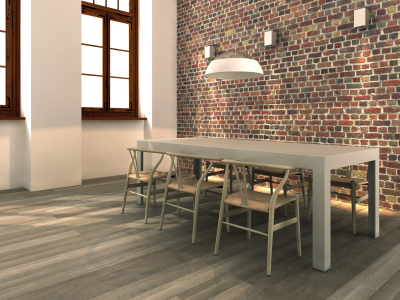People have loved the look of brick inside the home for decades now. The two most common DIY in-home brick projects are exposed brick and faux brick projects.
Exposed brick in your home can be part of a wall or used to create a fireplace surround. This material is both durable and attractive, but the finish can be compromised by cracking mortar and stains. Paint may also start to crack and peel. If you have exposed brick that is becoming unsightly, then there are many ways for you can refinish or resurface it.

Tools Needed
The tools used for refinishing or resurfacing brick can be found at any home improvement store. Basic tools needed for this task include gloves, a face mask, an angle grinder, a heat gun, a scraper, a putty knife, a paint sprayer, and paint brushes. You will also need a wire brush and eye protection.
Clean the Brick
Brick that looks dirty can easily be refinished by simple cleaning. White crystals that form on the brick is a form of Efflorescence. This chalky white coating leaches to the surface of the mortar in the form of mineral salts. There are many ways you can clean the brick to restore it to its original appearance.
The easiest way to clean efflorescence from brick is to mix a solution of water and vinegar into a spray bottle. Lightly spray the brick with the solution and let is set for a few minutes. If the efflorescence on the brick is thick in places, then scrubbing with a stiff bristle brush may be necessary. You may also mix a solution of 10 percent diluted muriatic acid to spray on the brick.
Stains that appear on exposed brick can be cleaned using a solution of water and oxalic acid. Mix up to 10 parts water with one part acid in container and pour it into a spray bottle. If you have copper fittings on the brick, then water drips can cause bluish stains. You can clean bluish stains on any exposed brick by mixing a four parts of talc with one part of ammonium chloride. A thick paste can be made by using a small amount of ammonia. Apply the paste to the stains on the brick and brush it off once the paste is dry. Make sure to wear eye protection and gloves when working with any type of chemicals.
Stripping
Old paint that shows signs of peeling and cracking can be stripped from the brick. Stripping is a way to restore your brick to its original appearance. You can strip paint from exposed brick with a commercial paint stripper. This is a chemical product that softens old paint. A scraper is then used to remove all old paint from the surface of the brick. Another option to strip paint is to use a heat gun. Paint can be taken off of the brick using a wire brush or a putty knife.
The use of chemical paint strippers creates fumes and will require a face mask or respirator is the brick is located inside. Paint strippers are also flammable. If you choose to use a heat gun, then old paint will give off fumes as it begins to melt.
Repoint the Brick
Cracks in the mortar of a brick wall can be repaired using a process called repointing. You need to have an angle grinder to complete this task. The angle grinder is used to grind away any cracked mortar on a brick wall. Mortar should be ground down to a depth of one-half to three-quarters of an inch. Clean out mortar joints with compressed air and a metal brush.
Mix a batch of mortar in a bucket using a power drill with a paddle attachment. Spray a water into your mortar joints to dampen the existing mortar. This will help the new mortar to stick. Apply the mortar into the joint by using a pointing trowel. Repoint vertical sections first and then move to horizontal areas of the wall. A striking tool then needs to be used to create a smooth looking mortar joint. Allow the mortar to dry and cure for at least two days before applying a masonry sealer.
Painting / Sealing / Staining
The easiest way to resurface brick is to use Portland cement-based paint, latex paint or stain or a silicone sealant. The stain and sealant options can give you the look that you often find in a modern city row-home. Applying paint or stain that is designed to resist moisture penetration is a good option for brick walls in a basement. The use of paint that allows water vapor to escape will prevent most water issues with your brick. If you choose to paint a brick wall, then make sure to repair all defects first. This includes any cracks and staining that is on the brick. Clean the brick thoroughly to ensure the new paint will stick to the brick. A paint brush or a paint sprayer can then be used to apply paint to any exposed brick. You can apply a brown and red colored paint to create the look of new bricks. Another option is to use gray paint on your existing mortar joints.
Tags: angle grinder, contemporary, exposed brick, heat gun, paint sprayer, putty knife
